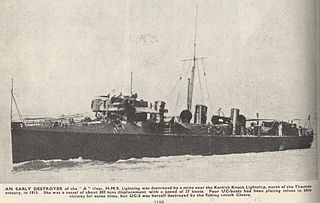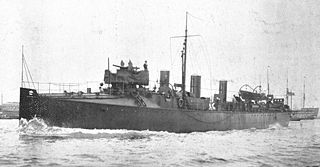Design and construction
On 3 November 1893 the British Admiralty placed an order with the Glasgow shipbuilder J&G Thomson as part of the 1893–1894 Naval Estimates for three torpedo-boat destroyers, Rocket, Shark and Surly, with Surly expected to be delivered within 16 months. [1] A total of 36 destroyers were ordered from 14 shipbuilders as part of the 1893–1894 Naval Estimates, all of which were required to reach a contract speed of 27 knots (50 km/h; 31 mph). [2] [3] The Admiralty laid down broad requirements for the destroyers, including speed, the use of an arched turtleback [a] forecastle and armament, with the detailed design left to the builders, resulting in each of the builders producing different designs. [5] [6]
Surly was 203 feet 9 inches (62.10 m) long overall and 200 feet (60.96 m) between perpendiculars, with a beam of 19 feet 6 inches (5.94 m) and a draught of 6 feet 9 inches (2.06 m). Displacement was 280 long tons (280 t ) light and 350 long tons (360 t) full load. Four Normand three-drum water-tube boilers fed steam at 200 pounds per square inch (1,400 kPa) to 2 triple expansion steam engines rated at 4,100 indicated horsepower (3,100 kW). Three funnels were fitted. [1] Armament consisted of a single QF 12 pounder 12 cwt [b] gun on a platform on the ship's conning tower (in practice the platform was also used as the ship's bridge) and three 6-pounder guns, with two 18 inch (450 mm) torpedo tubes. [7] One of the torpedo tubes could be removed to accommodate a further two six-pounders, [8] although by 1908 both five 6-pounder guns and both torpedo tubes were generally fitted. [9]
Surly was laid down at Thomson's Clydeside shipyard as yard number 271 on 14 February 1894 and was launched on 10 November 1894. [1] She reached a speed of 28.05 knots (51.95 km/h; 32.28 mph) during sea trials [10] and was commissioned in July 1895. [1]
Service
Surly spent her whole career in British waters, [11] and was based at Portsmouth. [12] She took part in the 1901 British Naval Manoeuvres. [13] Surly was used in trials in the use of oil fuel instead of coal from 1898, [14] [15] [11] which were still ongoing in 1906. [16]
On 30 August 1912 the Admiralty directed all destroyers were to be grouped into classes designated by letters based on contract speed and appearance. After 30 September 1913, as a 27-knotter, Surly was assigned to the A class. [17] [18] [19]
In March 1913, Surly was in commission with a nucleus crew at Portsmouth, as a tender for HMS Fisgard, the Royal Navy's training school for engineers. [20] [c] Surly remained at Portsmouth as a tender to Fisgard in July 1914, on the eve of the outbreak of the First World War. [22]
The Royal Navy mobilised its reserve forces on the eve of the outbreak of the First World War in August 1914, [23] and in January 1915, although still a tender to Fisgard, [24] [25] Surly was also a member of the Portsmouth Local Defence Flotilla. [26]
HMS Wolf was a B-class torpedo boat destroyer of the British Royal Navy. She was completed by Laird, Son & Company, Birkenhead in 1897.
HMS Zebra was a "Twenty-seven Knotter" destroyer of the Royal Navy, later classified as part of the A Class. Zebra was built by Thames Iron Works and launched in 1895 as the fifth Royal Navy ship to be named Zebra. Entering service in 1900, Zebra was sold for scrap in 1914.
HMS Boxer was an Ardent-class destroyer which served with the Royal Navy, launched on 28 November 1894. She spent several years operating with the Mediterranean Fleet and remained active during the First World War. She was sunk in a collision on 8 February 1918.

HMS Bruizer was an Ardent-class destroyer which served with the Royal Navy. She was launched on 27 February 1895 by John Thornycroft at Chiswick, and was sold on 26 May 1914.

HMS Charger was a Charger-class destroyer which served with the Royal Navy. She was launched by Yarrow Shipbuilders at Poplar, London on 15 September 1894, served in home waters and was sold off in 1912.
HMS Hasty was a Charger-class destroyer which served with the Royal Navy. She was launched by Yarrow Shipbuilders in 1894, served in home waters and was sold off in 1912.

HMS Dasher was a Charger-class destroyer which served with the Royal Navy. She was built by Yarrow Shipbuilders in 1895, served in home waters and was sold in 1911.
HMS Hardy was a Hardy-class destroyer which served with the Royal Navy. She was built by William Doxford & Sons in 1895, launched on 16 December 1895, and sold off on 11 July 1911.

HMS Lightning was a Janus-class destroyer of the British Royal Navy, later designated an A-class destroyer, built by Palmers and launched in 1895.
HMS Porcupine was a Janus-class destroyer of the Royal Navy. She was launched by Palmers Shipbuilding and Iron Company in 1895, served in home waters and was in service during the First World War.
HMS Fervent was a Fervent-class destroyer which served with the Royal Navy. Fervent was launched on 28 March 1895 at Paisley.

HMS Zephyr was one of two Fervent-class destroyers which served with the Royal Navy. She was launched on 10 May 1895 from Hanna, Donald & Wilson at Paisley, Scotland. She served in home waters, and was sold in 1920.

HMS Conflict was the lead ship of the Conflict-class destroyers built by J. Samuel White, at East Cowes, Isle of Wight for the Royal Navy. She was launched on 13 December 1894, and entered service in 1899. After an initial spell in the Mediterranean Fleet, Conflict returned to British waters, where she served the rest of her career. Conflict was part of the Portsmouth Local Defence Flotilla during the First World War, which she survived. Conflict was sold for scrap on 20 May 1920.

HMS Wizard was a Conflict-class destroyer built by the White shipyard for the Royal Navy, and launched on 26 February 1895. In 1910, she was reconstructed with only two funnels. She is believed to be the only destroyer fitted with in turning screws. She was sold in 1920.

HMS Sturgeon was the lead ship of the Sturgeon-class destroyers which served with the Royal Navy. Built by Vickers, she was launched in 1894 and sold in 1910.
HMS Peterel was one of two Spiteful-class destroyers to serve with the Royal Navy. She was built by Palmers, was 215 feet long and the 6,200 H.P. produced by her Reed boilers gave her a top speed of 30 knots. She was armed, as was standard, with a twelve pounder and two torpedo tubes. She served in home waters throughout the Great War and was sold off in 1919.
HMS Myrmidon was one of two Myrmidon-class destroyers which served with the Royal Navy.

HMS Sunfish was a "twenty-seven knotter" torpedo boat destroyer of the British Royal Navy. Built by the Tyneside shipbuilder Hawthorn Leslie, Sunfish was one of three destroyers built by Hawthorns that year. She was sold for scrap in 1920.

HMS Opossum was a "twenty-seven knotter" torpedo boat destroyer of the British Royal Navy. Built by the Tyneside shipbuilder Hawthorn Leslie, Opossum was one of three destroyers built by Hawthorns that were ordered in 1894. She was launched in 1895 and completed in 1896. She remained in service during the First World War, where she was used for local patrol duties based at Plymouth and sank the German submarine UC-49 on 8 August 1918. She was sold for scrap in 1920.

HMS Ranger was a "twenty-seven knotter" torpedo boat destroyer of the British Royal Navy. Built by the Tyneside shipbuilder Hawthorn Leslie, Opossum was one of three destroyers built by Hawthorns that were ordered in 1894. She was launched in 1895 and completed in 1896. She remained in service during the First World War, where she was used for local patrol duties. She was sold for scrap in 1920.
This page is based on this
Wikipedia article Text is available under the
CC BY-SA 4.0 license; additional terms may apply.
Images, videos and audio are available under their respective licenses.











